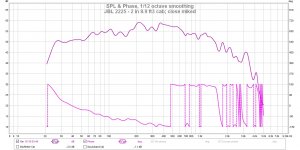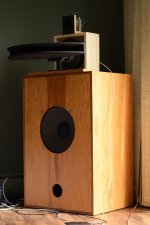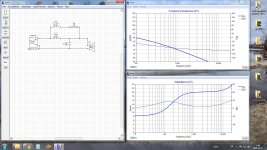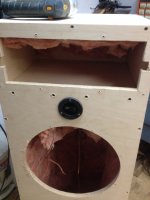Another opinion
Have been watching this thread. Your frustration is quite understandable. One would think a JBL 15" could, would pump out a ton of bass. And it can within limits. Have you measured the T/S values? Didn't notice any in the post history so far. You need to know what you really have. A Parts Express DATS or similar measurement system would be quite helpful. Do you have a DVM, or frequency generator? I have used the 2225H in a medium length two way scoop and it did very well into the mid 40's. I dialed in some baffle step compensation to provide better balance. On a 18" wide, give or take baffle, 2.5-3 db worked well in a medium large room with the enclosure close to the rear wall. Used a passive crossover of my design. Altec 500 Hz on top. This was quite a few years ago, but a proper design is a proper design. The 2225 series is a good driver and worthy of effort. Your enclosure is more than large enough for reflex performance. But exact net size and tuning has to based on actually driver T/S values. Otherwise, you get into SWAG area and lots of experimentation. J
Have been watching this thread. Your frustration is quite understandable. One would think a JBL 15" could, would pump out a ton of bass. And it can within limits. Have you measured the T/S values? Didn't notice any in the post history so far. You need to know what you really have. A Parts Express DATS or similar measurement system would be quite helpful. Do you have a DVM, or frequency generator? I have used the 2225H in a medium length two way scoop and it did very well into the mid 40's. I dialed in some baffle step compensation to provide better balance. On a 18" wide, give or take baffle, 2.5-3 db worked well in a medium large room with the enclosure close to the rear wall. Used a passive crossover of my design. Altec 500 Hz on top. This was quite a few years ago, but a proper design is a proper design. The 2225 series is a good driver and worthy of effort. Your enclosure is more than large enough for reflex performance. But exact net size and tuning has to based on actually driver T/S values. Otherwise, you get into SWAG area and lots of experimentation. J
my intent is to have a speaker enclosure in a full range mode that i can push to 200wrms and have as much low bass as i can. i dont want a amplified subwoofer, i have one already and i hate it (jbl stuff too)hence my reason to select another speaker, the 2225h seems not meant for this job
If you can model a 2235 in your box. Might be a bit big. That driver will give you a lower reach but you will loose some efficiency as the price. While you are at it verify the FS of your drivers and make sure you have original cones. A 2225 will not give you the first octave it's a 40hz woofer.
Rob 🙂
Last edited:
Have been watching this thread. Your frustration is quite understandable. One would think a JBL 15" could, would pump out a ton of bass. And it can within limits. Have you measured the T/S values? Didn't notice any in the post history so far. You need to know what you really have. A Parts Express DATS or similar measurement system would be quite helpful. Do you have a DVM, or frequency generator? I have used the 2225H in a medium length two way scoop and it did very well into the mid 40's. I dialed in some baffle step compensation to provide better balance. On a 18" wide, give or take baffle, 2.5-3 db worked well in a medium large room with the enclosure close to the rear wall. Used a passive crossover of my design. Altec 500 Hz on top. This was quite a few years ago, but a proper design is a proper design. The 2225 series is a good driver and worthy of effort. Your enclosure is more than large enough for reflex performance. But exact net size and tuning has to based on actually driver T/S values. Otherwise, you get into SWAG area and lots of experimentation. J
i do have a lot of testing and measuring equipements. fwiw in the early 90's i was making bandpass speakers and such for cars, from Alpine stuff. was very well in this and performed a lot of db spl tests, using audio controls RTA and such, now i am electronic designer for railways and such...i am not a wanabe....
i can make the dishes shake with the speaker...but with a 13uh inductor, a lot of eq compensation, horn is muffled down, 2--4khz is way too high, vocal seems to come from the back of the speaker and whats not. i made a lot of speakers in my life with 20$ components now this one, i wasted like 800$ in various components, so well...i am very disapointed, yes.
Have been watching this thread. Your frustration is quite understandable. One would think a JBL 15" could, would pump out a ton of bass. And it can within limits. Have you measured the T/S values? Didn't notice any in the post history so far. You need to know what you really have. A Parts Express DATS or similar measurement system would be quite helpful. Do you have a DVM, or frequency generator? I have used the 2225H in a medium length two way scoop and it did very well into the mid 40's. I dialed in some baffle step compensation to provide better balance. On a 18" wide, give or take baffle, 2.5-3 db worked well in a medium large room with the enclosure close to the rear wall. Used a passive crossover of my design. Altec 500 Hz on top. This was quite a few years ago, but a proper design is a proper design. The 2225 series is a good driver and worthy of effort. Your enclosure is more than large enough for reflex performance. But exact net size and tuning has to based on actually driver T/S values. Otherwise, you get into SWAG area and lots of experimentation. J
Here is my JBL speaker using 2225 driver in an 8.9 cu. ft. cabinet tuned to 30 Hz. I biamp with an analog active crossover.
The speakers are positioned in the room corners and the bass is good enough for me.
interesting, what are your cross over cut off settings ?
I have Nelson Pass' LX Mini active crossover modified for my speakers and the crossover between the bass and mid/highs is 1000 Hz. The JBL 2397 horns don't do well below about 900 Hz. I have a 2405 tweeter with a capacitor high pass at about 10 kHz.
Interestingly, the port for the cabinet is just a 4" diameter hole in the 5/8 inch plywood baffle.
Interestingly, the port for the cabinet is just a 4" diameter hole in the 5/8 inch plywood baffle.
You didn't mention which PRV horn you have. Is it a constant directivity type? If so, you need to add "CD compensation" as the response will peak around a couple kHz and then roll off to about 9dB down at the top octave. Without compensation and with the crossover HighPass, it will be a bad sounding midrange peak. See, for instance, Horn Equalization.
A good circuit for dealing with it is the "Econowave" crossover structure, or see Wayne Parham's designs, or use active EQ.
A good circuit for dealing with it is the "Econowave" crossover structure, or see Wayne Parham's designs, or use active EQ.
+1 fabricadetabaco -- on several posts, but especially the 'Don't give up!'
Those ports look kinda small to me, both OP's and pinholer's. All of the D130's, K140's and others I've run for decades have been in 5 and 8 cubic foot cabinets, are tuned much higher for the improved efficiency, are expecting heavy equalization, and are expected to tolerate being run hard. The port areas run typically 2 to 3 times the 4 inch diameter ones you fellas are showing; they're deeper (longer), too.
Aren't the commercial JBL cabinets (that you mentioned as having provided the inspiration) designed primarily as recording studio monitors? Those are usually pretty small rooms -- even by modest listening room standards. Smaller rooms are much easier to energize with bass; even more so if the cabinets are soffit-mounted. Stand-mount them a meter high a couple paces from the back wall in a 250 to 500 square foot room and suddenly they're notably feeble.
Any pair of 15's in a larger room will have trouble keeping up with just about any decent compression driver / horn combination. And that's regardless of passive crossovers, tri-amping, EQ, elaborate (horn) cabinet designs / tuning or whatever else you care to throw at it.
And please, forget about 20 Hz! To produce it exacts such a penalty in efficiency and other parameters that it isn't worth it. There's no music there -- it's an octave below the biggest symphonic bass drums -- unless you listen to a lot of very well-recorded classical organ, or synth-bass in Funk or Techno. If you can produce enough fundamental to decently represent the 'B' string of a 5-string bass guitar (30,87 Hz @A=440), consider it a *win*. A good example can be found in Nathan East's work on the CD/album 'Compositions' by Anita Baker.
Keep At It,
Regards
Those ports look kinda small to me, both OP's and pinholer's. All of the D130's, K140's and others I've run for decades have been in 5 and 8 cubic foot cabinets, are tuned much higher for the improved efficiency, are expecting heavy equalization, and are expected to tolerate being run hard. The port areas run typically 2 to 3 times the 4 inch diameter ones you fellas are showing; they're deeper (longer), too.
Aren't the commercial JBL cabinets (that you mentioned as having provided the inspiration) designed primarily as recording studio monitors? Those are usually pretty small rooms -- even by modest listening room standards. Smaller rooms are much easier to energize with bass; even more so if the cabinets are soffit-mounted. Stand-mount them a meter high a couple paces from the back wall in a 250 to 500 square foot room and suddenly they're notably feeble.
Any pair of 15's in a larger room will have trouble keeping up with just about any decent compression driver / horn combination. And that's regardless of passive crossovers, tri-amping, EQ, elaborate (horn) cabinet designs / tuning or whatever else you care to throw at it.
And please, forget about 20 Hz! To produce it exacts such a penalty in efficiency and other parameters that it isn't worth it. There's no music there -- it's an octave below the biggest symphonic bass drums -- unless you listen to a lot of very well-recorded classical organ, or synth-bass in Funk or Techno. If you can produce enough fundamental to decently represent the 'B' string of a 5-string bass guitar (30,87 Hz @A=440), consider it a *win*. A good example can be found in Nathan East's work on the CD/album 'Compositions' by Anita Baker.
Keep At It,
Regards
@OP
you mention you have a JBL sub which also performs bad. Can you elaborate? Can you show some pictures of your room and speaker placement + listening position?
I think there is more to the story here than the build.
you mention you have a JBL sub which also performs bad. Can you elaborate? Can you show some pictures of your room and speaker placement + listening position?
I think there is more to the story here than the build.
^ sure and this following statement should be the first on list of concerns. But if it is a constant directivity horn without compensation eq with an imperfect balance between drivers and no bsc to start with, of course the loudspeakers need to be fixed first as it must sound bad.
my room is large, 20x20 if not more...
Can you post a FR and an impedance plot of that speaker? Or better three frequency response plots, one of each speaker from 1m distance and another one from the stereo pair in your listening position?
And schematics of the crossovers used so far with a note what belongs to what post about the changes.
And schematics of the crossovers used so far with a note what belongs to what post about the changes.
what sub i have ??
JBL PB12 subwoofer, Class D amp, dead.
it evolved with a plate amp and a new speaker in it, but is not really used (understand: used as a flower pot)
i think this 2225 has a mechanical failure in it. at very low volume the mid seems to rub against the magnet. ie, voice coil is mechanically damaged.
my room is actually larger than 20x20.
JBL PB12 subwoofer, Class D amp, dead.
it evolved with a plate amp and a new speaker in it, but is not really used (understand: used as a flower pot)
i think this 2225 has a mechanical failure in it. at very low volume the mid seems to rub against the magnet. ie, voice coil is mechanically damaged.
my room is actually larger than 20x20.
Hi,
It's not about the size of your room but the ratio between them. Square room have really difficult behavior regarding room modes ( hence bass). That said if you have a door you can keep open to the rest of the house it can be manageable ( more or less, not worst than other situation anyway).
I hope your driver is not damaged. Coil recentering can be done with dedicated servicing professional if needed.
Like others i think you shouldn't give up regarding this project, could be rewarding in the end.
It's not about the size of your room but the ratio between them. Square room have really difficult behavior regarding room modes ( hence bass). That said if you have a door you can keep open to the rest of the house it can be manageable ( more or less, not worst than other situation anyway).
I hope your driver is not damaged. Coil recentering can be done with dedicated servicing professional if needed.
Like others i think you shouldn't give up regarding this project, could be rewarding in the end.
Last edited:
my listening room is defenitively not square, it points toward a diner room and a corridor too. no matter what, if the speakers, positionned where they are, cannot play well, they just wont be left there or wont be ever part of my system. I have 2 towers in the exact same location in each corners and they play extremely well so it wouldnt make sens to me that the jbl would perform this bad because of this current location. let me know if this is logical and rational.
You didn't mention which PRV horn you have. Is it a constant directivity type? If so, you need to add "CD compensation" as the response will peak around a couple kHz and then roll off to about 9dB down at the top octave. Without compensation and with the crossover HighPass, it will be a bad sounding midrange peak. See, for instance, Horn Equalization.
A good circuit for dealing with it is the "Econowave" crossover structure, or see Wayne Parham's designs, or use active EQ.
i have noticed a severe gain in the 2k-6k from the horn. so i guess the econowave compensate for this ?
i was attempting to try a notch filter, so i simulated it in lxsim.
the horn driver i am using is PRV D260MY-B, with a reproduction jbl wide horn.
i am making my homework
i reduced the internal volume by enclosing the horn itself. i am at 5ft3 dead on by doing so.
i also found out that the heavy mass of the unsupported horn is probably the source of the 120hz resonance i was experiencing. dont blame me on the fiberglass wool hanging....i will get sucured#tacked back on properly once finished with this.
now in the process to reduce the port lenght to the prescribed 40hz tuning so about 1.2" long...damns thats short !
I DONT HAVE 6 inche tube in stock....loool. where in the hell can i find 6 inch tube.
i reduced the internal volume by enclosing the horn itself. i am at 5ft3 dead on by doing so.
i also found out that the heavy mass of the unsupported horn is probably the source of the 120hz resonance i was experiencing. dont blame me on the fiberglass wool hanging....i will get sucured#tacked back on properly once finished with this.
now in the process to reduce the port lenght to the prescribed 40hz tuning so about 1.2" long...damns thats short !
I DONT HAVE 6 inche tube in stock....loool. where in the hell can i find 6 inch tube.
Attachments
6 inch diameter and 1,2 length?
Doesnt seem right to me.
I would expect more like 8x10cm BR?
Anyway good to see you try stuff but please measure your drivers free air. If the coil is hitting / scraping the gap you’re out of luck with the driver.
Please also draw the room layout so we can advice.
Doesnt seem right to me.
I would expect more like 8x10cm BR?
Anyway good to see you try stuff but please measure your drivers free air. If the coil is hitting / scraping the gap you’re out of luck with the driver.
Please also draw the room layout so we can advice.
- Home
- Loudspeakers
- Multi-Way
- JBL project goes wrong, advice needed



